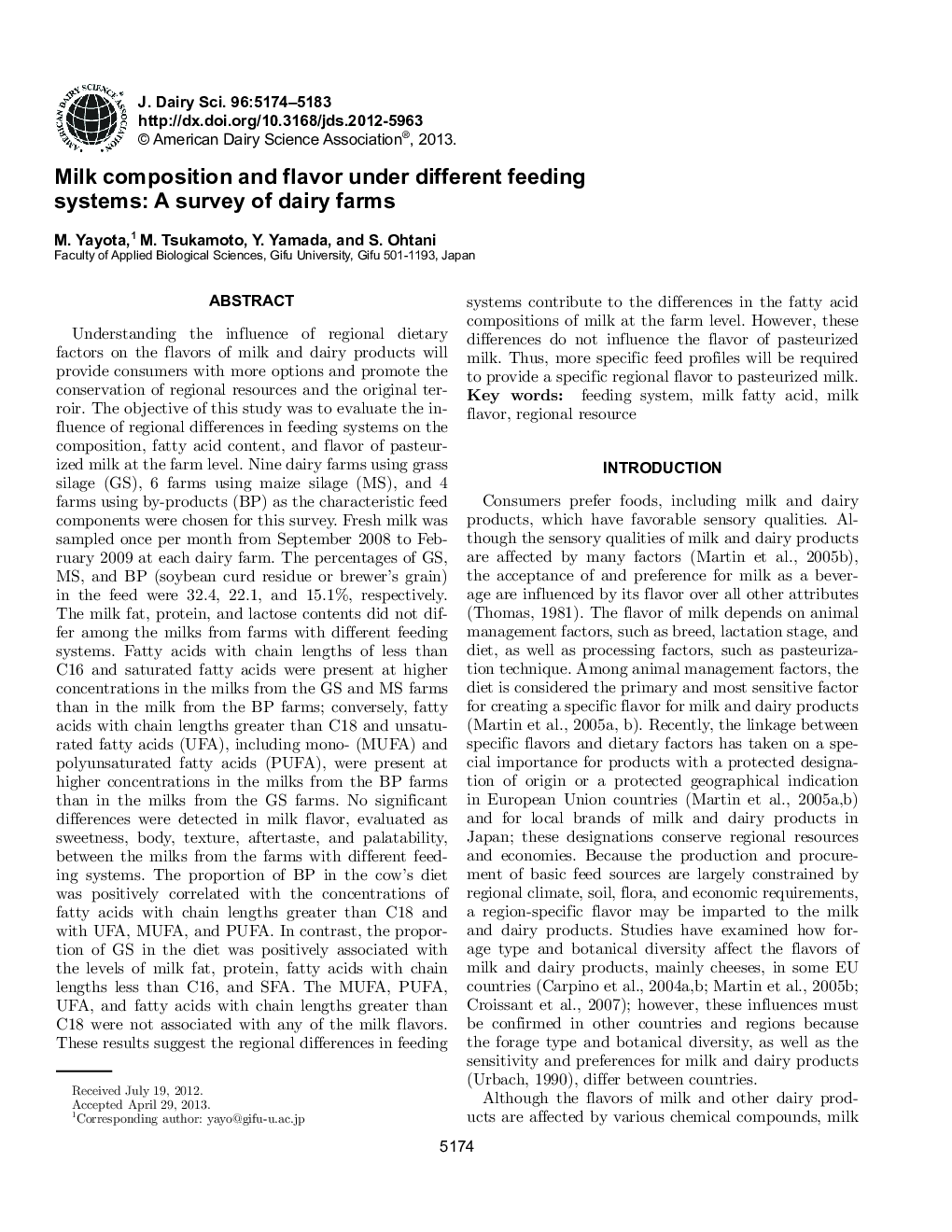| کد مقاله | کد نشریه | سال انتشار | مقاله انگلیسی | نسخه تمام متن |
|---|---|---|---|---|
| 2438897 | 1108051 | 2013 | 10 صفحه PDF | دانلود رایگان |
عنوان انگلیسی مقاله ISI
Milk composition and flavor under different feeding systems: A survey of dairy farms
دانلود مقاله + سفارش ترجمه
دانلود مقاله ISI انگلیسی
رایگان برای ایرانیان
موضوعات مرتبط
علوم زیستی و بیوفناوری
علوم کشاورزی و بیولوژیک
علوم دامی و جانورشناسی
پیش نمایش صفحه اول مقاله

چکیده انگلیسی
Understanding the influence of regional dietary factors on the flavors of milk and dairy products will provide consumers with more options and promote the conservation of regional resources and the original terroir. The objective of this study was to evaluate the influence of regional differences in feeding systems on the composition, fatty acid content, and flavor of pasteurized milk at the farm level. Nine dairy farms using grass silage (GS), 6 farms using maize silage (MS), and 4 farms using by-products (BP) as the characteristic feed components were chosen for this survey. Fresh milk was sampled once per month from September 2008 to February 2009 at each dairy farm. The percentages of GS, MS, and BP (soybean curd residue or brewer's grain) in the feed were 32.4, 22.1, and 15.1%, respectively. The milk fat, protein, and lactose contents did not differ among the milks from farms with different feeding systems. Fatty acids with chain lengths of less than C16 and saturated fatty acids were present at higher concentrations in the milks from the GS and MS farms than in the milk from the BP farms; conversely, fatty acids with chain lengths greater than C18 and unsaturated fatty acids (UFA), including mono- (MUFA) and polyunsaturated fatty acids (PUFA), were present at higher concentrations in the milks from the BP farms than in the milks from the GS farms. No significant differences were detected in milk flavor, evaluated as sweetness, body, texture, aftertaste, and palatability, between the milks from the farms with different feeding systems. The proportion of BP in the cow's diet was positively correlated with the concentrations of fatty acids with chain lengths greater than C18 and with UFA, MUFA, and PUFA. In contrast, the proportion of GS in the diet was positively associated with the levels of milk fat, protein, fatty acids with chain lengths less than C16, and SFA. The MUFA, PUFA, UFA, and fatty acids with chain lengths greater than C18 were not associated with any of the milk flavors. These results suggest the regional differences in feeding systems contribute to the differences in the fatty acid compositions of milk at the farm level. However, these differences do not influence the flavor of pasteurized milk. Thus, more specific feed profiles will be required to provide a specific regional flavor to pasteurized milk.
ناشر
Database: Elsevier - ScienceDirect (ساینس دایرکت)
Journal: Journal of Dairy Science - Volume 96, Issue 8, August 2013, Pages 5174-5183
Journal: Journal of Dairy Science - Volume 96, Issue 8, August 2013, Pages 5174-5183
نویسندگان
M. Yayota, M. Tsukamoto, Y. Yamada, S. Ohtani,